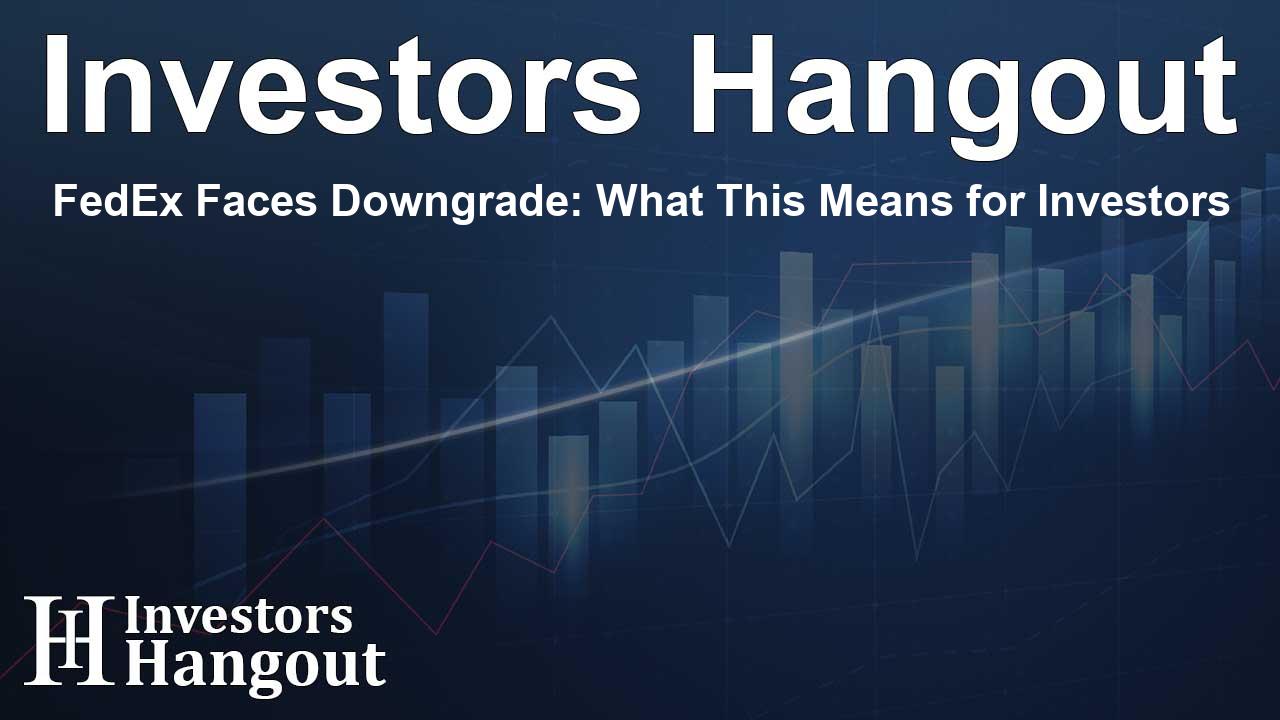FedEx Faces Downgrade: What This Means for Investors

FedEx's Recent Downgrade: A Shift in Strategy
In recent market news, FedEx (NYSE: FDX) saw a significant shift in its stock rating, as HSBC changed its stance from Buy to Hold. This decision accompanied a lowered price target of $300, down from a prior $350. This adjustment comes amid a backdrop of revised earnings forecasts that reflect a challenging financial environment for the logistics giant.
Factors Behind the Downgrade
The HSBC analyst provided key insights into this downgrade, primarily attributing it to a decrease in anticipated volumes and profit margins. The firm adjusted their forecast for fiscal year 2025, projecting a non-GAAP EBIT of $6.8 billion. This is 8% lower than previous estimates, and notably falls 3% below FedEx's own guidance midpoint of $7.0 billion, indicating a miss against broader consensus expectations.
Analysts' Earnings Projections
Furthermore, non-GAAP EPS projections for FedEx were also lowered by 6%, now estimated at $20.09. This is 2% beneath the guidance midpoint, raising concerns among investors about the company's profitability prospects amidst increasing operational challenges.
Comparison with Competitors
When examining FedEx's stock trajectory this year, it managed to rally by an impressive 21%, reflecting resilience in a volatile market. In contrast, competitors like UPS and DHL reported declines, with UPS shares down 13% and DHL experiencing a drop of 7%. This disparity highlights FedEx's competitive positioning even as it navigates these turbulent waters.
Long-Term Stock Performance
Interestingly, over the last two years, FedEx's stock has nearly doubled, showcasing a dramatic increase of 92.5%. This surge starkly contrasts with UPS’s 20% decline and aligns closely with the S&P 500's 51% appreciation. Analysts believe that much of this stock performance stems from the successful implementation of FedEx's restructuring plan, which now appears to be largely factored into the stock's current valuation.
Outlook and Analyst Ratings
In light of recent adjustments, other analysts have weighed in on their perspectives regarding FedEx's future. Raymond James lowered its price target to $310 but maintained an Outperform rating, citing ongoing strategic initiatives such as the DRIVE program. Conversely, TD Cowen adjusted their target to $328 while still holding a Buy rating, signaling cautious optimism concerning FedEx's long-term growth potential. Meanwhile, Jefferies expressed caution, lowering its target to $275 while maintaining a Hold rating amidst lower-than-expected profit margins.
Market Insights
Adding further complexity, Susquehanna reduced its price target to $330 yet holds a Positive rating, indicating a belief in FedEx's capacity to rebound. Stifel echoed similar sentiments, adjusting their target to $321 while retaining a Buy rating, indicating a willingness to support the stock despite prevailing headwinds.
FedEx's Financial Health
As FedEx maneuvers through these recalibrated expectations, key financial indicators remain essential for investors to consider. The company boasts a market capitalization of $73.58 billion, with a P/E ratio currently sitting at 17.26. This is noteworthy, especially given the downward adjustments in analyst ratings and the elevated P/E ratio concerning anticipated earnings growth.
Stability Amidst Adjustments
Nevertheless, FedEx retains a robust history, having maintained dividend payments for 23 consecutive years, which offers a degree of reassurance to dividend-focused investors. The current dividend yield stands at 1.85%, affirming FedEx's ongoing commitment to delivering shareholder value.
What Lies Ahead for Investors?
With analysts forecasting continued profitability for FedEx this year, amid the challenges posed by altered market conditions, many view the company as a critical player in the Air Freight & Logistics sector. The recent stock performance has exhibited notable resilience, with a total return of 19.31% over the past three months. For those closely monitoring FedEx's trajectory, understanding these dynamics is crucial for making informed investment decisions.
Frequently Asked Questions
Why did HSBC downgrade FedEx's rating?
HSBC downgraded FedEx due to decreased earnings expectations and anticipated declines in volumes and yields, projecting lower EBIT and EPS results.
What is FedEx's new price target?
The new price target set by HSBC for FedEx is $300, down from the previous target of $350.
How has FedEx's stock performed compared to its competitors?
FedEx's stock has risen by 21% this year, while UPS has fallen by 13% and DHL by 7%, indicating strong relative performance.
What is FedEx's market capitalization?
FedEx currently has a market capitalization of $73.58 billion.
How long has FedEx maintained dividend payments?
FedEx has consistently paid dividends for 23 consecutive years, reflecting its commitment to shareholder returns.
About Investors Hangout
Investors Hangout is a leading online stock forum for financial discussion and learning, offering a wide range of free tools and resources. It draws in traders of all levels, who exchange market knowledge, investigate trading tactics, and keep an eye on industry developments in real time. Featuring financial articles, stock message boards, quotes, charts, company profiles, and live news updates. Through cooperative learning and a wealth of informational resources, it helps users from novices creating their first portfolios to experts honing their techniques. Join Investors Hangout today: https://investorshangout.com/
Disclaimer: The content of this article is solely for general informational purposes only; it does not represent legal, financial, or investment advice. Investors Hangout does not offer financial advice; the author is not a licensed financial advisor. Consult a qualified advisor before making any financial or investment decisions based on this article. The author's interpretation of publicly available data shapes the opinions presented here; as a result, they should not be taken as advice to purchase, sell, or hold any securities mentioned or any other investments. The author does not guarantee the accuracy, completeness, or timeliness of any material, providing it "as is." Information and market conditions may change; past performance is not indicative of future outcomes. If any of the material offered here is inaccurate, please contact us for corrections.